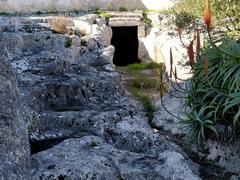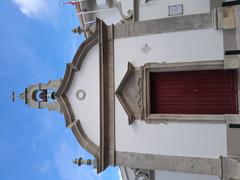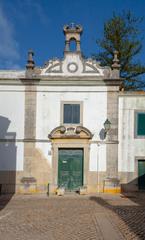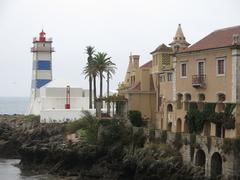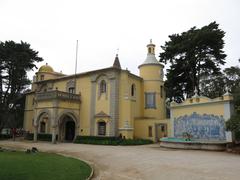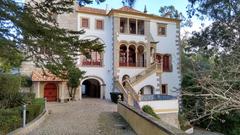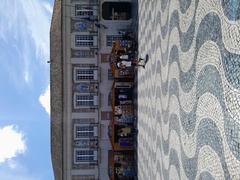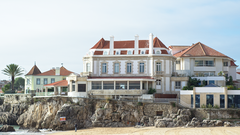
Bateria Alta ao Norte da Praia da Água Doce: Complete Visiting Guide to Estoril’s Historic Coastal Battery
Date: 04/07/2025
Introduction
Along the dramatic coastline of Estoril, Portugal, Bateria Alta ao Norte da Praia da Água Doce stands as a striking symbol of the region’s maritime defense legacy and natural allure. This coastal artillery battery, perched on cliffs north of Praia da Água Doce, presents a unique convergence of military history, cultural significance, and breathtaking Atlantic vistas. Constructed between the 17th and 19th centuries, Bateria Alta was integral to a defensive network that protected Lisbon and surrounding communities from naval threats during pivotal conflicts, including the Restoration War and the Peninsular War. Today, it attracts history lovers, cultural travelers, and nature enthusiasts alike, offering free public access and enriching guided tours.
This comprehensive guide details Bateria Alta’s history, practical visitor information, local attractions, environmental context, and tips for maximizing your visit. Whether you seek a window into Portugal’s coastal defense strategies or simply wish to enjoy the scenic Estoril-Cascais coast, Bateria Alta invites exploration and discovery.
For the latest updates, official resources such as the Estoril Cultural Heritage website and Visit Cascais are recommended.
Table of Contents
- Introduction
- Historical Background and Strategic Importance
- Visiting Bateria Alta ao Norte da Praia da Água Doce
- What to See and Do
- Nearby Attractions and Amenities
- Natural Environment and Landscape
- Environmental Stewardship and Visitor Conduct
- Cultural Events and Community Engagement
- Practical Tips for Visitors
- Frequently Asked Questions (FAQ)
- Conclusion & Call to Action
- References
1. Historical Background and Strategic Importance
Coastal Defense in the Age of Empires
Bateria Alta was constructed as part of a broader system of coastal fortifications safeguarding Lisbon and the Cascais-Estoril region from seaborne attacks. The battery’s elevated position, north of Praia da Água Doce, provided clear visibility over the Atlantic, enabling timely detection of approaching enemy vessels. Its strategic location complemented nearby defenses such as Forte de Santo António da Barra and Forte de Oitavos, forming overlapping fields of fire critical to local and national security during periods of conflict, including the Restoration War and Napoleonic invasions (QuestoApp).
Architectural Features and Military Technology
Typical of 17th–19th-century Portuguese batteries, Bateria Alta features robust masonry bastions, stone parapets, and gun emplacements designed to withstand naval artillery and harsh coastal weather. The elevated bastion enabled effective engagement with ships and deterred enemy landings. Ammunition storage and defensive structures were integrated into the cliffs, often camouflaged to blend with the landscape—an approach that continued into the 20th century as coastal defenses modernized.
Role in Regional Security and Trade
Bateria Alta’s primary function was to protect Lisbon’s approaches and ensure the safety of vital maritime trade routes. Its presence reassured local communities and merchants, supporting economic stability and growth. In times of heightened danger, the battery was staffed by regular troops or local militias, serving both practical and symbolic roles as a deterrent to potential aggressors.
2. Visiting Bateria Alta ao Norte da Praia da Água Doce
Visiting Hours and Tickets
- Opening Hours: Daily, 9:00 AM to 6:00 PM (exterior grounds accessible during daylight hours).
- Admission: Free for all visitors.
- Guided Tours: Available on weekends and public holidays; advanced booking recommended via the Estoril Cultural Heritage website or local visitor centers.
How to Get There
- By Car: Parking available nearby along Avenida Marginal and at the grounds of adjacent hotels.
- By Public Transport: Take the Cascais Line train from Lisbon’s Cais do Sodré to Estoril Station. From there, local buses (441, 442) or a scenic 20-minute coastal walk north leads to the battery.
- On Foot or By Bike: Well-marked coastal trails connect Estoril, Cascais, and Praia da Água Doce, offering spectacular views.
Accessibility
- Terrain is uneven, with some steep sections. Wheelchair access is limited; visitors with mobility concerns should contact the local visitor center for guidance and assistance.
Guided Tours and Educational Programs
- Tours led by heritage specialists provide insight into the site’s military history, architecture, and environmental context. Educational workshops are occasionally available for schools and cultural groups.
3. What to See and Do
- Explore the Bastion: Walk the preserved stone walls and bastion for panoramic views of the Atlantic and Praia da Água Doce.
- Interpretive Signage: Learn about the history and function of the battery through onsite panels.
- Photography: Capture sunrise or sunset shots with the dramatic cliffside and ocean backdrop.
- Attend Special Events: Participate in guided tours, heritage days, or occasional reenactments hosted by local organizations.
4. Nearby Attractions and Amenities
- Forte de Santo António da Barra: A historic fort with a lighthouse and small museum.
- Praia da Água Doce: Relax on the beach or take a coastal walk.
- Estoril Casino and Gardens: Entertainment, dining, and leisure options.
- Cascais Historic Center: Explore shops, markets, and museums in this lively coastal town.
5. Natural Environment and Landscape
Coastal Geology and Topography
The site sits atop rugged limestone cliffs, part of the broader Estoril-Cascais coastal system. Erosion has created dramatic formations, tidal pools, and coves, which provided natural defense advantages and scenic beauty (Geoparque Oeste).
Flora and Fauna
Mediterranean scrubland, wild olive, juniper, and rockrose dominate the landscape. The cliffs are home to diverse birdlife, including gulls and kestrels, and the intertidal zone teems with marine organisms. Spring brings wildflowers and an abundance of pollinators (Instituto da Conservação da Natureza e das Florestas).
Climate and Seasonal Variations
Estoril’s mild Mediterranean climate, moderated by Atlantic breezes, ensures pleasant conditions for most of the year. Summers are warm (22–28°C), while winters are cool but rarely cold. Peak visitation occurs in summer; off-peak seasons offer quieter experiences (IPMA - Portuguese Institute for Sea and Atmosphere).
6. Environmental Stewardship and Visitor Conduct
Help preserve Bateria Alta’s historic and natural value by staying on marked paths, refraining from climbing on structures, and carrying out litter. Respect local flora and fauna, and support conservation efforts by following posted guidelines (ICNF).
7. Cultural Events and Community Engagement
The battery hosts occasional events, including European Heritage Days, guided walks, and historical reenactments organized by local authorities. These programs foster community engagement and promote the site’s role in regional heritage (European Heritage Days Portugal).
8. Practical Tips for Visitors
- Footwear: Wear sturdy shoes due to rocky, uneven ground.
- Weather: Bring a light jacket for evening breezes.
- Photography: Early morning or late afternoon offers the best light.
- Booking: Reserve guided tours or restaurant tables in advance, especially in summer.
- Accessibility: Contact local tourism offices for details if you have mobility needs.
- Respect: As a classified monument, avoid disturbing historic structures.
9. Frequently Asked Questions (FAQ)
Q: What are the visiting hours?
A: The site is open daily from 9:00 AM to 6:00 PM (exterior access).
Q: Is there an entrance fee?
A: No, entry to Bateria Alta is free.
Q: Are guided tours available?
A: Yes, on weekends and public holidays; book ahead via official channels.
Q: How do I get there by public transport?
A: Take the Cascais Line train to Estoril, then walk or use local buses northward.
Q: Is the site accessible for people with disabilities?
A: Accessibility is limited due to terrain; contact the visitor center for assistance.
Q: Can I visit without a hotel reservation?
A: Yes, the historical battery grounds are open to the public, though some areas are integrated with hotel property.
10. Conclusion & Call to Action
Bateria Alta ao Norte da Praia da Água Doce offers a compelling mix of history, culture, and scenic beauty—making it a must-visit landmark on the Estoril and Cascais coast. Its preserved fortifications, panoramic Atlantic views, and integration with local attractions create a layered visitor experience. Ongoing community stewardship and heritage programs ensure its continued vitality for future generations.
Plan your visit by checking official tourism portals and event calendars. Download the Audiala app for interactive maps, detailed guides, and exclusive content about Estoril’s historical sites. Follow us on social media for current updates, event announcements, and travel inspiration.
11. References
- Bateria Alta ao Norte da Praia da Água Doce - Património Cultural
- Forte da Cruz (Estoril) - QuestoApp
- Bateria Alta - Cultura Cascais
- Cascais Municipality
- Visit Cascais
- European Heritage Days Portugal
- Instituto da Conservação da Natureza e das Florestas (ICNF)
- IPMA - Portuguese Institute for Sea and Atmosphere



